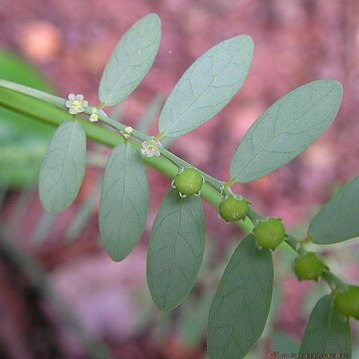Herbs, annual, monoecious, 1–4 dm; branching phyllanthoid. Stems: main stems angled, not winged, glabrous; ultimate branchlets subterete, narrowly winged, ± scabridulous. Leaves on main stems spiral, scalelike; stipules not auriculate, pale green to nearly white. Leaves on ultimate branchlets distichous, well developed; stipules not auriculate, pale green to nearly white; blade elliptic-oblong, 6–11 × 3–5 mm, base cuneate to obtuse, apex rounded, both surfaces glabrous. Inflorescences cymules or flowers solitary, unisexual, proximal with 2–3 staminate flowers, distal with 1 pistillate flower. Pedicels: staminate 0.2–0.5 mm, pistillate spreading in fruit, 1.3–2 mm. Staminate flowers: sepals 6, white to pale yellow, flat, 0.4–0.7 mm; nectary extrastaminal, 6 glands; stamens 3, filaments connate throughout. Pistillate flowers: sepals 6, green with broad white margins, flat, (1–)1.2–1.5 mm, 1-veined; nectary annular, 6–9-lobed. Capsules 2.1 mm diam., smooth. Seeds uniformly brown, 0.9–1.1 mm, longitudinally ribbed.
Female flowers: pedicels 0.5 mm long, extending to 1 mm in fruit; sepals 6, 1 × 0.5 mm, not or scarcely accrescent, the outer oblong-lanceolate, the inner oblong to oblanceolate, obtuse to rounded, white with an olive-green midrib; disk 0.6 mm across, very irregularly laciniate or divided; ovary 0.5 mm in diameter, subsessile, 3-lobed to subglobose, smooth, greenish; styles 3, 0.25 mm long, divergent, shortly bifid, stigmas recurved.
Male flowers: pedicels 0.5 mm long, capillary; sepals 6, 0.7 × 0.5 mm, obovate-suborbicular, the 3 outer apiculate, the inner obtuse, translucent with an opaque greenish-yellow midrib; disk glands 6, free, 0.1 mm across, flattened, lobulate and tuberculate; stamens 3, filaments connate into a column 0.25 mm high, anthers 0.2 mm across, reniform, obliquely held, apically dehiscent.
Leaf blades 0.5–1.3 × 0.15–0.5 cm, elliptic-oblong, obtuse or rounded at the apex, cuneate to rounded at the base, membranaceous, glabrous, dark green above, paler and somewhat greyish-green beneath; lateral nerves in 4–7 pairs, scarcely visible above, slightly prominent beneath.
Seeds 1 × 0.8 × 0.7 mm, segmentiform, yellowish-brown, with 6–7 longitudinal ridges of close packed darker brown, transversely lineate tubercles on the dorsal facet, and 5–7 concentric ridges on each ventral facet, with innumerable parallel transverse striae between them.
A small herb. It grows each year from seeds. The branches are angled. The leaves are compound with leaflets along the stalk that do not have leaflet stalks. The flowers are small and under the leaf stalk. The fruit are small and round.
Male flowers in few-flowered cymules in the axils of the lowest quarter of the lateral shoots, females solitary in the rest, with occasionally the transitional axil bisexual.
Foliage leaves distichous; petioles 0.5 mm long; stipules 1 mm long, linear-lanceolate, whitish with a brownish midrib.
An asperulous to subglabrous erect annual herb commonly up to 45 cm tall, rarely taller, monoecious.
Lead shoots angular, straw coloured; lateral shoots up to 10 cm long, commonly much less.
Scale leaves 1 mm long, linear-subulate; stipules 0.8–1 mm long, triangular-lanceolate.
Fruit 1.1–1.2 × 1.6 mm, rounded-3-lobed, smooth, ochreous.

